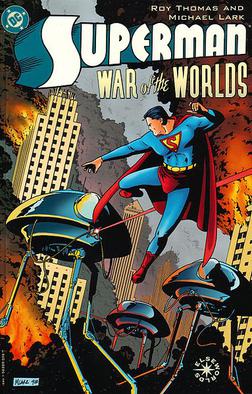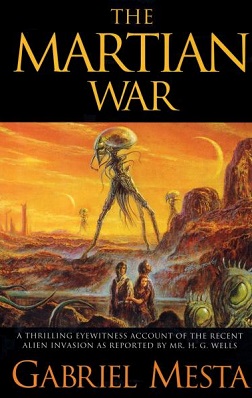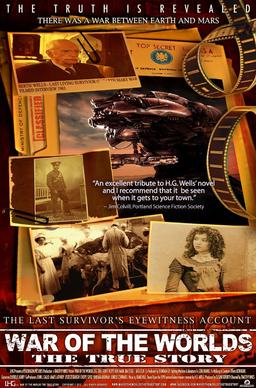The War of the Worlds is an 1898 science fiction novel by H. G. Wells.

Alien invasion or space invasion is a common feature in science fiction stories and film, in which extraterrestrial lifeforms invade the Earth to exterminate and supplant human life, enslave it, harvest people for food, steal the planet's resources, or destroy the planet altogether. It can be considered as a science-fiction subgenre of the invasion literature, expanded by H. G. Wells's seminal alien invasion novel The War of the Worlds.

John Carter of Mars is a fictional Virginian soldier who acts as the initial protagonist of the Barsoom stories by Edgar Rice Burroughs. A veteran of the American Civil War, he is transported to the planet Mars, called Barsoom by its inhabitants, where he becomes a warrior battling various mythological beasts, alien armies and malevolent foes. Created in 1911, the character has appeared in novels and short stories, comic books, television shows and films, including the 2012 feature film John Carter, which marked the 100th anniversary of the character's first appearance.

HMS Thunder Child is a fictional ironclad torpedo ram of the Royal Navy, destroyed by Martian fighting-machines in H. G. Wells' 1898 novel The War of the Worlds whilst protecting a refugee rescue fleet of civilian vessels. It has been suggested that Thunder Child was based on HMS Polyphemus, which was the sole torpedo ram to see service with the Royal Navy from 1881 to 1903.

The fighting machine is one of the fictional machines used by the Martians in H.G. Wells' 1898 classic science fiction novel The War of the Worlds. In the novel, it is a fast-moving three-legged walker reported to be 100 feet tall with multiple whip-like tentacles used for grasping, and two lethal weapons: the Heat-Ray and a gun-like tube used for discharging canisters of a poisonous chemical black smoke that kills humans and animals. It is the primary machine the Martians use when they invade Earth, along with the handling machine, the flying machine, and the embankment machine.

The First Men in the Moon is a scientific romance, originally serialised in The Strand Magazine and The Cosmopolitan from November 1900 to June 1901 and published in hardcover in 1901, by the English author H. G. Wells, who called it one of his "fantastic stories". The novel tells the story of a journey to the Moon undertaken by the two protagonists: a businessman narrator, Mr. Bedford; and an eccentric scientist, Mr. Cavor. Bedford and Cavor discover that the Moon is inhabited by a sophisticated extraterrestrial civilisation of insect-like creatures they call "Selenites". The inspiration seems to come from the famous 1865 book by Jules Verne, From the Earth to the Moon, and the opera by Jacques Offenbach from 1875. Verne's novel also uses the word "Selenites" to describe inhabitants of the Moon.
As an adjective, Martian means of or pertaining to the planet Mars.

The Martians, also known as the Invaders, are the race of extraterrestrials and the main antagonists from the H.G. Wells 1898 novel The War of the Worlds. They are the main antagonists of the novel, and their efforts to exterminate the populace of the Earth and claim the planet for themselves drive the plot and present challenges for the novel's human characters. They are notable for their use of extraterrestrial weaponry far in advance of that of mankind at the time of the invasion.

Star Begotten is a 1937 novel by H. G. Wells. It tells the story of a series of men who conjecture upon the possibility of the human race being altered, through genetic modification, by Martians to replace their own dying planet.

Superman: War of the Worlds is a DC Comics Elseworlds comic story, published in 1998, written by Roy Thomas with Michael Lark as the artist. The story is a rough adaptation of the H. G. Wells 1898 novel The War of the Worlds, but is primarily based on the Superman mythology. Wells' story is transported from early 20th century Britain to Metropolis in 1938, where the Martian invasion is met with a Golden Age-style Superman who is not blessed with the full range of powers that he typically has in modern comics.

H. G. Wells' The War of the Worlds is a 2005 direct-to-video independent science fiction action horror-thriller film version adaptation of H. G. Wells's 1898 novel of the same name about a Martian invasion of southern England. This version was produced by the independent film company Pendragon Pictures. Unlike the adaptations set in the current day United States, this was the first film set in the novel's original 1898 Victorian England. In 2012, a re-formatted, re-worked version of the film was released as War of the Worlds – The True Story.

The Martian War: A Thrilling Eyewitness Account of the Recent Invasion As Reported by Mr. H.G. Wells is a 2005 science fiction novel by American writer Kevin J. Anderson, published under his pseudonym Gabriel Mesta. It is a retelling of H.G. Wells' 1898 novel The War of the Worlds similar to Anderson's past work War of the Worlds: Global Dispatches. It recounts the Martian invasion from a variety of viewpoints, and has ties to Wells' other work.

The League of Extraordinary Gentlemen, Volume II is a comic book limited series written by Alan Moore and illustrated by Kevin O'Neill, published under the America's Best Comics imprint of DC Comics in the United States and under Vertigo in the United Kingdom. It is a sequel to the original volume of The League of Extraordinary Gentlemen and like its previous installment is a pastiche of various characters and events from Victorian literature; though it borrows a great number of characters and elements from various literary works of writers such as Sir Arthur Conan Doyle, Edgar Rice Burroughs, Ian Fleming, Robert Louis Stevenson and Bram Stoker, it is predominantly a retelling of The War of the Worlds by H. G. Wells.

War of the Worlds 2: The Next Wave is a 2008 direct-to-DVD science fiction-action film by The Asylum, which premiered on Syfy on Tuesday March 18, 2008, directed by and starring C. Thomas Howell. The film was produced and distributed independently by The Asylum.

The Day the Earth Stopped is a 2008 American direct-to-DVD science fiction action horror film produced by independent studio The Asylum, directed by and starring C. Thomas Howell. It is a mockbuster of the 2008 remake of The Day the Earth Stood Still, which was released three days later. Howell stars as the protagonist, soldier Josh Myron, who witnesses the arrival of giant alien robots that threaten to destroy the Earth unless they are shown the value of human existence.

The War of the Worlds is a 1953 American science fiction film directed by Byron Haskin, produced by George Pal, and starring Gene Barry and Ann Robinson. It is the first of several feature film adaptations of H. G. Wells' 1898 novel of the same name. The setting is changed from Victorian era England to 1953 Southern California.

War of the Worlds: The True Story is a 2012 american made-for-television science fiction-action film remake of H. G. Wells' The War of the Worlds based on English writer H. G. Wells's epic 1898 science fiction novel The War of the Worlds. A documentary-style drama directed by Timothy Hines, it revisits Wells' novel, portraying the events of the book as historical, through the documented recollections of a survivor of the Martian war.

The War of the Worlds is a science fiction novel by English author H. G. Wells. It was written between 1895 and 1897, and serialised in Pearson's Magazine in the UK and Cosmopolitan magazine in the US in 1897. The full novel was first published in hardcover in 1898 by William Heinemann. The War of the Worlds is one of the earliest stories to detail a conflict between humankind and an extraterrestrial race. The novel is the first-person narrative of an unnamed protagonist in Surrey and his younger brother in London as southern England is invaded by Martians. It is one of the most commented-on works in the science fiction canon.

The War of the Worlds is a 2019, three-part, British science fiction drama, produced by Mammoth Screen for the BBC and co-produced with Creasun Media and Red Square. The series is an Edwardian period adaptation of H.G. Wells' 1898 science fiction novel of the same name about a Martian invasion, and is the first British television adaptation of the novel. The War of the Worlds premiered in other countries before its UK broadcast on the BBC between 17 November and 1 December 2019.

















